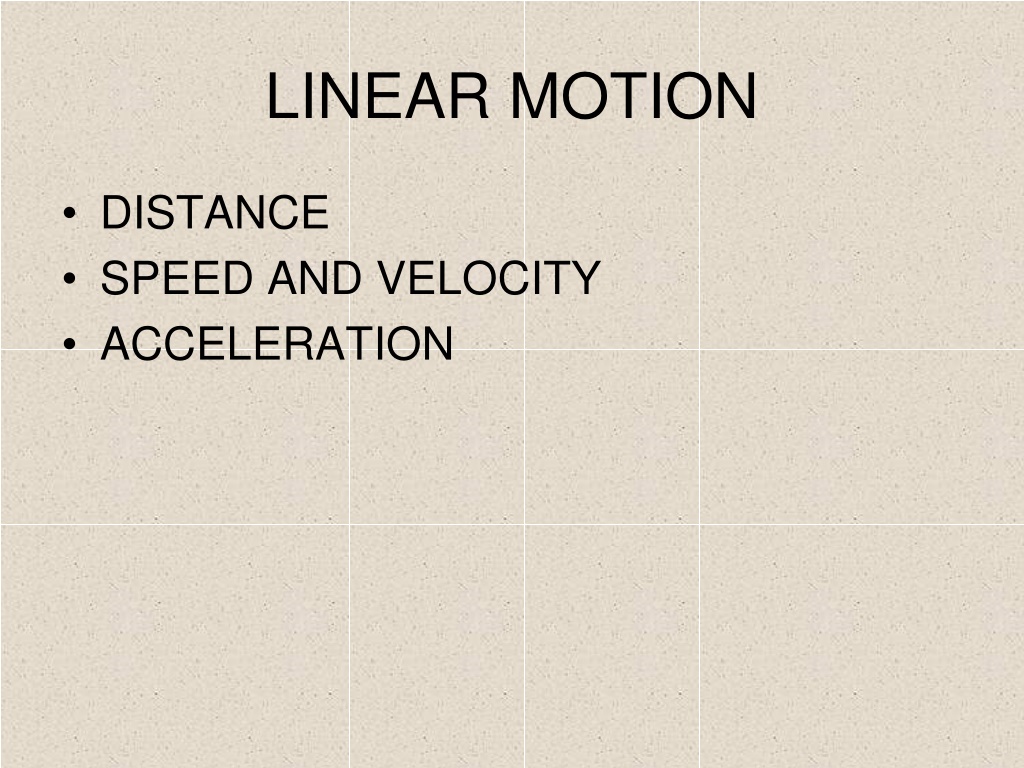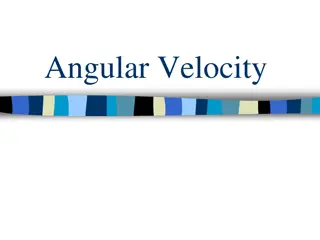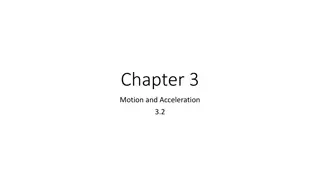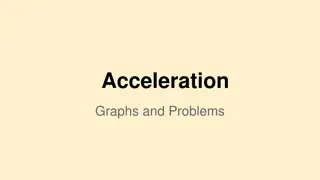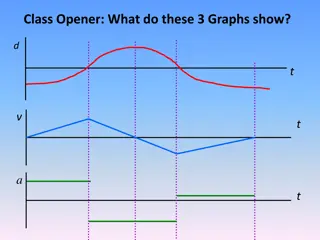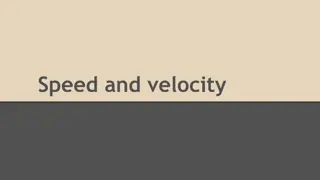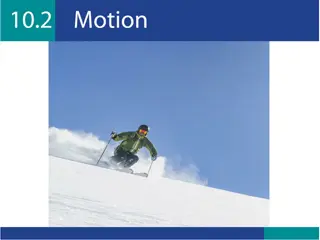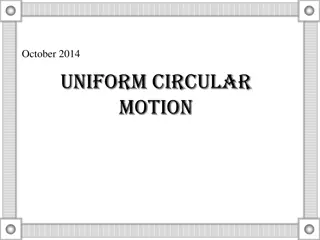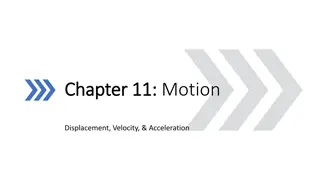Understanding Linear Motion: Distance, Speed, Velocity, and Acceleration
Explore the concepts of linear motion in physics, including distance, speed, velocity, and acceleration. Learn how to calculate average speed, interpret graphs, and convert units. Engage in practical experiments to investigate everyday objects' motion. Enhance your understanding through illustrations and example calculations provided.
Uploaded on Oct 06, 2024 | 0 Views
Download Presentation

Please find below an Image/Link to download the presentation.
The content on the website is provided AS IS for your information and personal use only. It may not be sold, licensed, or shared on other websites without obtaining consent from the author. Download presentation by click this link. If you encounter any issues during the download, it is possible that the publisher has removed the file from their server.
E N D
Presentation Transcript
LINEAR MOTION DISTANCE SPEED AND VELOCITY ACCELERATION
Specification Forces and motion Movement and position plot and interpret distance-time graphs know and use the relationship: average speed = distance moved / time taken describe experiments to investigate the motion of everyday objects such as toy cars or tennis balls know and use the relationship: acceleration = change in velocity / time taken a = (v u) / t plot and interpret velocity-time graphs determine acceleration from the gradient of a velocity-time graph determine the distance travelled from the area between a velocity-time graph and the time axis.
Average Speed average speed = distance time In physics speed is usually measured in: metres per second (m/s)
also: distance = speed x time distance and: time = distance speed speed time
Speed Conversions 1 kilometre per hour (km/h) = 1000 metres per hour but 1 hour = 3600 seconds therefore 1 km/h = 1000m 3600 s 1 km/h = 0.28 m/s and 1 m/s = 3.6 km/h Also: 100 km/h = approx 63 m.p.h
Question 1 Calculate the average speed of a car that covers 500m in 20s. average speed = distance time = 500m / 20s = 25 m/s (about 60 mph)
Question 2 Sound waves travel at about 340m/s through air. How far will a sound wave travel in one minute?
Question 2 Sound waves travel at about 340m/s through air. How far will a sound wave travel in one minute? distance = speed x time = 340 m/s x 1 minute = 340 m/s x 60 seconds = 20 400 m (20.4 km)
Complete distance time average speed 60 m 3 s m/s m 35 s 40 m/s 300 m s 1500 m/s 80 km 2 h km/h 150 x 10 6 km Min s 3.0 x 108 m/s 1 km s 330 m/s
Complete distance time average speed 20 m/s 20 60 m 3 s 1400 m 1400 35 s 40 m/s 0.20 s 0.20 300 m 1500 m/s 80 km 2 h 40 km/h 40 150 x 10 6 km 8 min 20 s 8 20 3.0 x 108 m/s 1 km 3.03 s 3.03 330 m/s
The slope or gradient of a distance-time graph increases with speed. distance time
The slope or gradient of a distance-time graph is equal to the speed. In the graph opposite: slope = 150m / 10s = 15 m/s = speed
Question 1 Sketch on the same set of axes distance- time graphs for: (a) a car moving at a steady speed, (b) a bus moving at a steady speed greater than the car, (c) a lorry increasing in speed from rest.
Question 1 lorry Sketch on the same set of axes distance- time graphs for: (a) a car moving at a steady speed, (b) a bus moving at a steady speed greater than the car, (c) a lorry increasing in speed from rest. distance time
Question 2 Describe the motion of the three lorries X, Y and Z shown in the graph below.
Lorry X: Moving quickest speed = 45000m / 1800s = 25 m/s Lorry Y: speed = 36000m / 1800s = 20 m/s Lorry Z: Moving slowest 0 to 600s; speed = 10000m / 600s = 16.7 m/s 600 to 1200s; stationary 1200 to 1800s; speed = 16.7 m/s average speed = 20000m / 1800s = 11.1 m/s
Choose appropriate words to fill in the gaps below: Speed is equal to ________ divided by time and can be measured in _________ per second. A speed of 20 m/s is the same as ______ km/h which is approximately equal to ______ mph. The _________ of a distance against time graph can be used to calculate ________. The greater the gradient of the line the __________ is the speed. The line will be ___________ when the speed is zero. WORD SELECTION: speed slope distance horizontal 40 higher 72 metres
Choose appropriate words to fill in the gaps below: Speed is equal to ________ divided by time and can be measured in _________ per second. metres distance A speed of 20 m/s is the same as ______ km/h which is approximately equal to ______ mph. 40 72 The _________ of a distance against time graph can be used to calculate ________. The greater the gradient of the line the __________ is the speed. The line will be ___________ when the speed is zero. slope speed higher horizontal WORD SELECTION: speed slope distance horizontal 40 higher 72 metres
Velocity The velocity of a body is its speed in a given direction. The airplane opposite may loop at a constant speed but its velocity changes as its direction of motion changes.
Question A stone dropped off the top of a cliff falls down by 20m in 2s. Calculate its average velocity (a) downwards and (b) horizontally. (a) average speed downwards = 20m / 2s = 10m/s Therefore velocity downwards = 10 m/s (b) average speed horizontally = 0m / 2s = 0m/s Therefore velocity horizontally = 0 m/s
Acceleration acceleration = velocity change a = (v u) / t time taken a = acceleration in metres per second squared (m/s2) v = final velocity in m/s u = initial velocity in m/s t = time taken in seconds (s)
Why is acceleration measured in m/s2 ? acceleration = velocity change time taken velocity change is measured in m/s time taken is measured in s therefore acceleration = m/s s = m/s2
Other notes: 1. Speed and velocity: Often, but not always, speed can be used in the equation. 2. Change in velocity: = final velocity initial velocity = v - u 3. Deceleration: This is where the speed is decreasing with time. 4. Circular motion at a constant speed: Acceleration is occurring because the direction of motion is continually changing and hence so is velocity.
Question 1 Complete the table below for an airplane accelerating at 8m/s2. time (s) 0 1 2 3 4 velocity (m/s) 0 8 16 24 32
Question 2 Calculate the acceleration of a car that changes in velocity from 5m/s to 25m/s in 4 seconds.
Question 2 Calculate the acceleration of a car that changes in velocity from 5m/s to 25m/s in 4 seconds. a = (v u) / t = (25m/s 5m/s) / 4s = 20 / 4 acceleration = 5 m/s2
Question 3 Calculate the final velocity of a train that accelerates at 0.3m/s2 for 60 seconds from an initial velocity of 5m/s.
Question 3 Calculate the final velocity of a train that accelerates at 0.3m/s2 for 60 seconds from an initial velocity of 5m/s. a = (v u) / t becomes: (v u) = a x t = 0.3m/s2 x 60s = 18m/s therefore final train velocity = 5m/s + 18m/s = 23 m/s
Question 4 Calculate the deceleration of a car that slows down from 18m/s to rest in 3 seconds.
Question 4 Calculate the deceleration of a car that slows down from 18m/s to rest in 3 seconds. a = (v u) / t = (0m/s 18m/s) / 3s = -18 / 3 (notice minus sign) acceleration = - 6 m/s2 and so deceleration = 6 m/s2 Note: Deceleration is the negative of acceleration.
Choose appropriate words to fill in the gaps below: Velocity is speed measured in a particular ______________. A person walking northwards will have _______ velocity in a westwards direction. Acceleration is equal to ________ change divided by the time taken. Acceleration is measured in metres per second ______. Deceleration occurs when a body is _________ down. It is possible for a body to be accelerating even when its ______ is not changing provided its direction is, for example: a body moving in a ________. WORD SELECTION: speed zero slowing direction squared circle velocity
Choose appropriate words to fill in the gaps below: Velocity is speed measured in a particular ______________. direction A person walking northwards will have _______ velocity in a westwards direction. zero Acceleration is equal to ________ change divided by the time taken. Acceleration is measured in metres per second ______. velocity squared Deceleration occurs when a body is _________ down. It is possible for a body to be accelerating even when its ______ is not changing provided its direction is, for example: a body moving in a ________. circle slowing speed WORD SELECTION: speed zero slowing direction squared circle velocity
Velocity-time graphs The slope of a velocity-time graph represents acceleration. velocity constant velocity or zero acceleration time
The area under a velocity-time graph represents distance travelled. velocity area equals distance travelled time
Question 1 velocity (m/s) Sketch the velocity time graph of a car accelerating from rest to 15m/s in 3 seconds and then remaining at a constant speed for one more second. 15 10 5 1 2 3 4 time (s)
Question 2 Calculate the acceleration and the distance travelled after 4 seconds from using the graph opposite. velocity (m/s) 12 8 4 area 1 2 3 4 time (s)
Question 2 Calculate the acceleration and the distance travelled after 4 seconds from using the graph opposite. velocity (m/s) 12 acceleration = gradient = y-step x-step = (12 - 0)m/s (4 0)s = 12 / 4 acceleration = 3 m/s2 8 4 area distance = area under the graph = area of triangle = x base x height = x 4s x 12m/s distance travelled = 24m 1 2 3 4 time (s)
Question 3 Calculate the acceleration and distance travelled using the graph shown below.
Acceleration: Acceleration equals the slope of the graph = y-step x-step = (16 - 4)m/s (10s) = 12 / 10 Acceleration = 1.2 m/s2 Distance travelled: This equals the area below the graph = area of rectangle + area of triangle = (10s x 4m/s) + ( x 10s x (12 4)m/s) = 40m + 40m Distance travelled = 80m
Question 4 Calculate the distance travelled over 15 seconds and the deceleration during the final five seconds using the graph below.
Distance travelled: This equals the area below the graph = area of rectangle + area of triangle = (10s x 20m/s) + ( x 5s x 20m/s) = 200m + 50m Distance travelled = 250m Deceleration: Acceleration equals the slope of the graph = y-step x-step = (- 20m/s) (5s) = - 4 m/s2 but deceleration = negative of acceleration Deceleration = 4 m/s2
Distance-time graphs The gradient of a distance-time graph is equal to the speed
Displacement-time graphs The gradient of a displacement-time graph is equal to the velocity The graph opposite shows how the displacement of an object thrown upwards varies in time. Note how the gradient falls from a high positive value to zero (at maximum height) to a large negative value. Estimate the initial velocity of the object. Initial gradient = (5 0)m / (0.5 0)s = 10 ms-1 Initial velocity = 10 ms-1
Question Describe the motion shown by the displacement-time graph below: s / m D O A: acceleration from rest C A B: constant velocity B E B C: deceleration to rest C D: rest (no motion) D E: acceleration from rest back towards the starting point A t / s
Question 2 The graph shows the velocity- time graph of a car. Calculate or state: (a) the acceleration of the car during the first 4 seconds. (b) the displacement of the car after 6 seconds. (c) time T. (d) the displacement after 11 seconds. (e) the average velocity of the car over 11 seconds. v / ms-1 12 t / s T 4 6 11 -10
Question 2 a) the acceleration of the car during the first 4 seconds. acceleration = gradient = (12 - 0)ms-1 / (4 0)s = 12 / 4 acceleration = 3 ms-2 v / ms-1 12 t / s T 4 6 11 -10
Question 2 (b) the displacement of the car after 6 seconds. displacement = area = area A + area B = (12 x 4) + (12 x 2) = 24 + 24 displacement = 48 m v / ms-1 12 area A area B t / s T 4 6 11 -10
Question 2 (c) time T. By similar triangles: (T - 6):(11 - T) = 12:10 i.e. (T - 6) / (11 - T) = 12 / 10 (T - 6) / (11 - T) = 1.20 (T - 6) = 1.20 (11 T) T - 6 = 13.2 1.2T 2.2T = 19.2 T = 19.2 / 2.2 T = 8.73 seconds v / ms-1 12 area A area B t / s T 4 6 11 -10 Note: T can also be found by scale drawing or by using the equations of uniform acceleration (see later).
Question 2 (d) the displacement after 11 seconds. displacement = area = area A + area B + area C = 24 + 24 + (12 x 2.73) (10 x 2.27) = 24 + 24 + 16.38 11.35 = 53.03 displacement = 53.0 m v / ms-1 12 area A area B area C area D t / s T 4 6 11 area D -10
